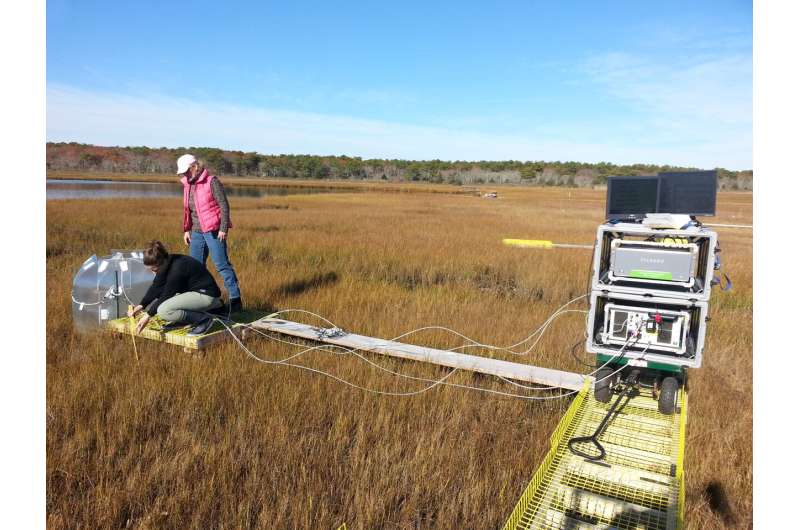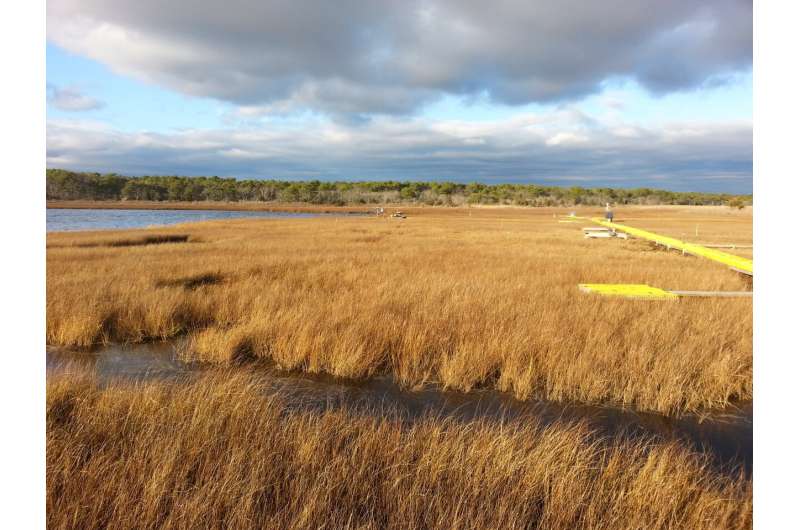As temperatures rise, low marsh emits more carbon gas than high marsh

Salt marshes are a well-known carbon sink and can aid in carbon sequestration efforts. But they are also dynamic ecosystems that change with the seasons and tides.
New research out of the Marine Biological Laboratory (MBL) Ecosystems Center shows how seasonal cycles and the ocean's ebb and flow affect the amount of carbon stored in New England marshes, using Sage Lot Pond on Cape Cod as a reference marsh.
"In our recent study, we asked: How does marsh respiration (the conversion of organic carbon to carbon dioxide) vary as a function of temperature, both of air and sediment? This can help us understand how climate change, particularly warming, alters respiration rates in a marsh," said Joanna Carey, associate professor of environmental science at Babson College. Carey conducted this research while an MBL postdoctoral scientist with Jianwu (Jim) Tang, MBL senior scientist, and Kevin Kroeger, supervisory research chemist with the U.S. Geological Survey.
Carey and her collaborators looked at gas exchange from the Sage Lot Pond marsh system over 16 months between 2014 and 2016. They installed static gas chambers in six plots, from high elevation marsh (which is flooded only a few days a month with the tides) to low elevation marsh (which is flooded twice daily with tides). The chambers recorded amount of carbon dioxide released to the atmosphere each second for four minutes straight. The large date range and varied elevations allowed them to capture data representing a spectrum of seasonal temperatures experienced by the marsh.
Upon reviewing the data, they saw that each degree of warming correlated with an exponential increase in carbon dioxide emission.

"But what was surprising is that we found higher temperature sensitivity in the low marsh habitat. That means for each degree of warming, there was significantly more carbon dioxide released from the marsh at lower elevation relative to the high-marsh habitat," Carey said.
Low marshes store more carbon, which had seemed like a good thing for natural carbon sequestration—especially since sea-level rise is resulting in the conversion of high-marsh to low marsh environments. But this research shows that as the world warms, the sequestration benefit from low marshes may be diminished, since carbon dioxide is released there at a much higher rate with increasing temperatures.
Sage Lot Pond is a well-quantified marsh, with a number of studies detailing various aspects of carbon movement. The study also showed that this Sage Lot marsh environment loses much more respired carbon to the ocean via ebbing tides than it does directly via vertical fluxes to the air. This is important, because although some of the respired carbon will be returned to the atmosphere as a carbon dioxide flux from the sea, a portion likely remains dissolved in the ocean for extended time, perhaps thousands of years, thereby enhancing the carbon sequestration value of salt marshes.
Carey and her collaborators hope to continue in this line of work by studying nitrogen loads and emissions using similar techniques. They also want to see how their findings might extend to other marshes. Tracking the fate of carbon and other gases in marshland gives a fuller picture that can inform policies to address climate change and help us understand the fate of these valuable ecosystems.
More information: Joanna C. Carey et al, Higher Temperature Sensitivity of Ecosystem Respiration in Low Marsh Compared to High Elevation Marsh Ecosystems, Journal of Geophysical Research: Biogeosciences (2022). DOI: 10.1029/2022JG006832
Provided by Marine Biological Laboratory




















